How to heal wounds quickly and effectively with honey
Honey is an antibiotic treatment that is recorded and recognized by many countries around the world thousands of years ago, during the First World War. Today's doctors and health professionals also recognize the benefits of honey in treating wounds and many other problems. Honey not only helps to kill bacteria but also maintains moisture to the wound and acts as a " protective barrier ". Besides, honey also helps reduce inflammation and promotes wound healing and other skin problems. Buy honey ( locally or commercially available ) at home, you can use honey as an antibiotic on the spot for skin wounds or diseases such as acne. Please take a look at how to quickly and effectively heal wounds with honey below!
Part 1: Apply honey to the wound
1. Find the right type of honey

Although it is possible to use any kind of honey to treat wounds, some types such as Manuka honey ( one of the special types of honey originating from Australia and New Zealand ) can make medicine. topical antibiotics are more effective than others such as topical antibiotics . You should buy some honey available for home use when needed.
- Keep in mind that locally produced honey has the ability to kill bacteria in the most effective way. In addition, you can also buy certified medical honey because these honey products are often available at safe food stores, local markets, even in some grocery stores.
- Be careful when buying honey outside because often contains unknown additives or origin, so the ability to kill bacteria and cure wounds is not very effective. Note to read the brand and make sure the honey you buy is pure and sterilized.
2. Clean the wound
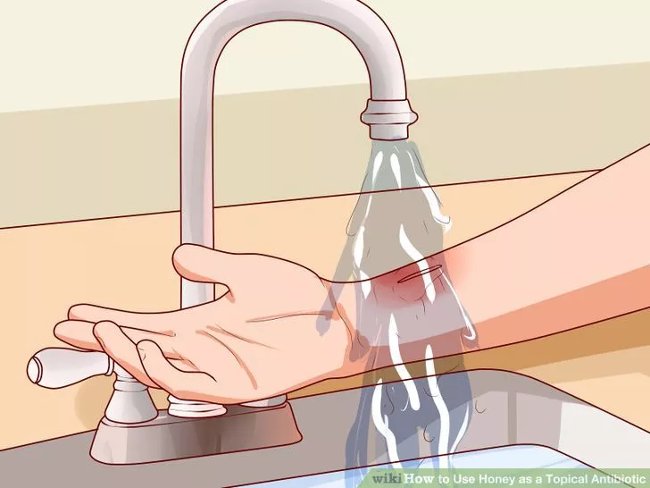
First, you need to clean the wound and remove all the debris on the wound surface when applying honey. Cleaning the wound helps kill bacteria and reduces the risk of infection.
- First, gently wash the wound with warm water and soap. No need to use special products to clean the wound because all soaps can clean dirt and debris equally effectively. Remember to wash the wound until there is no residue of soap, dirt or debris on the wound surface.
- After that, wipe the wound dry with a clean towel.
- Do not remove debris deep inside to avoid the spread of bacteria and increase the risk of infection. Instead, you should go to the doctor to pick up the debris.
3. Bandage the wound with honey

Apply honey to the wound after cleansing and drying. Spread a layer of honey evenly over the gauze pad, then place gauze on the wound's mouth. This helps protect the wound and kill bacteria.
- Apply honey on one side of a gauze or clean cloth.After that, the face was covered with honey on the wound.Note that the tape's coverage must be wider than the wound to kill bacteria in the surrounding tissue.Avoid pushing the bandage into the wound.Instead, gently press or place on and around the wound to make sure the honey is in contact with the skin.
- Hold the tape securely with medical tape.If there is no medical tape, you can use regular tape.
4. Apply honey directly to the wound
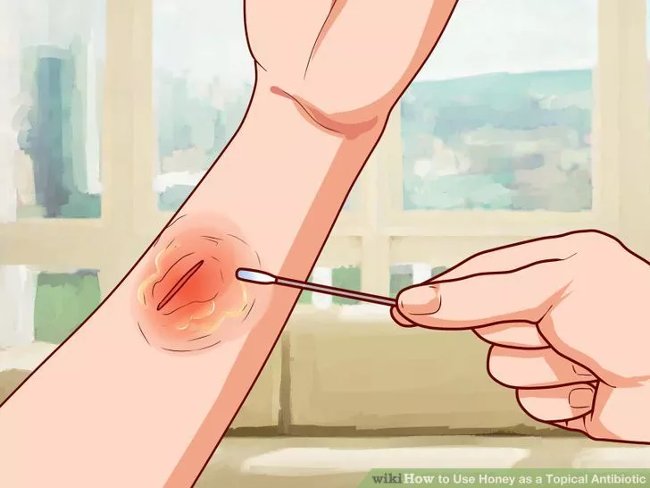
If you want, you can pour honey directly onto the wound. This method makes honey more effective in contacting the wound.
- Use a finger, a cotton swab or a clean cloth to spread or spread a thin layer of honey on the wound.If desired, you can measure 15 to 30ml of honey and pour it directly onto the wound.Remember to spread honey out to the area near the wound to destroy the bacteria in the surrounding tissue.Then, use a clean bandage to cover the wound and fix it with a medical tape or regular tape.
5. Repeat the treatment process
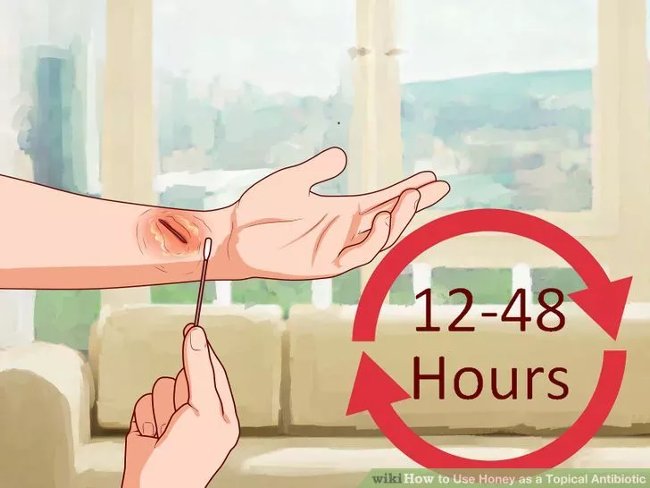
In most cases, every 12 to 48 hours ( depending on the severity and progress of the wound ) should be applied once. Clean the wound clean and apply honey regularly as needed, until the wound heals. In addition, you should see a doctor if the wound is not healing or signs of infection such as redness, heat, pain, pus or red rash appear.
- About two days, you should check once to make sure the wound is not infected. Every time you check your wound, wash your hands thoroughly and place a fresh, clean bandage on the wound.
Part 2: Treating other diseases with honey
1. Soothe burns with honey
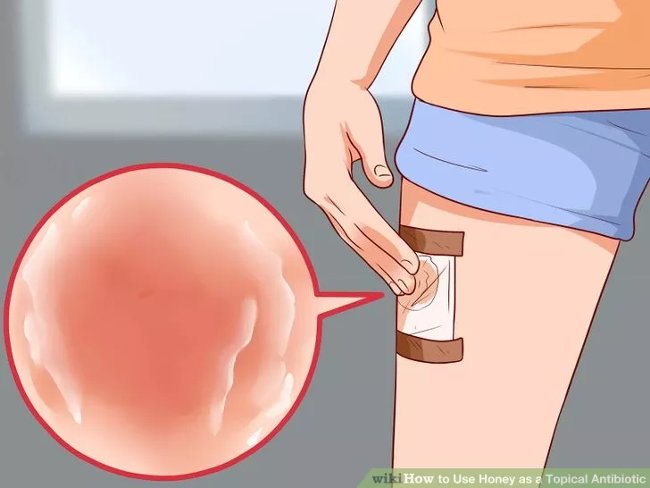
If burned or burned, honey will soothe and help the burn heal faster. Applying honey to clean gauze or cloth, then placing it on the burn will help treat it more effectively than pouring honey directly onto the burn. Fix the gauze pad with regular medical tape or duct tape and check for burns on a regular basis.
2. Treat acne
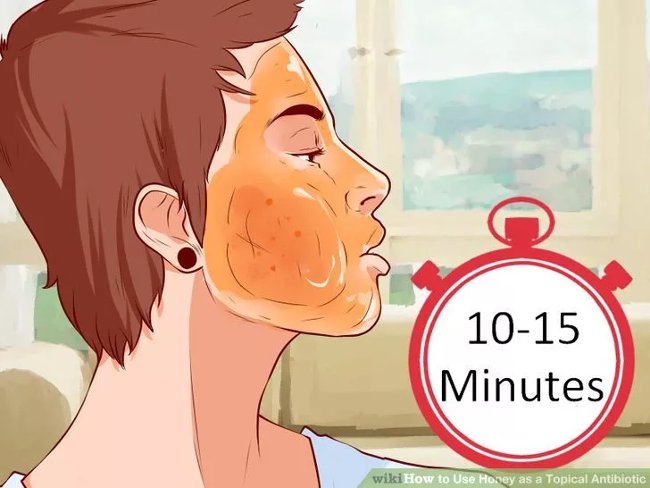
Honey helps to moisturize skin naturally and kill bacteria that cause acne. Apply a thin layer of honey to your skin or apply a honey mask to treat and prevent acne and help your skin look whiter.
- First, apply a layer of warm honey to your face.Leave on for 10 to 15 minutes, then rinse with warm water.
- Next, mix one tablespoon of honey with one teaspoon of baking soda.Gently rub the mixture onto the skin to exfoliate, cleanse and moisturize the skin.Besides, a mixture of two teaspoons of honey and one teaspoon of fresh lemon juice can also kill bacteria that cause acne.
3. Treatment of skin nodules

Some people often have nodules on the skin, which are clumps of tissue that appear on different parts of the body. Applying a honey mask is very useful in cases of rash or easily floating on the skin.
- Preparing a honey mask helps shrink the nodules.Mix one teaspoon of honey with one of any of the following ingredients: lemon juice, avocado, coconut oil, egg white or yogurt.
- Apply the mask for a few minutes, then rinse with warm water.
4. Kill fungal bacteria
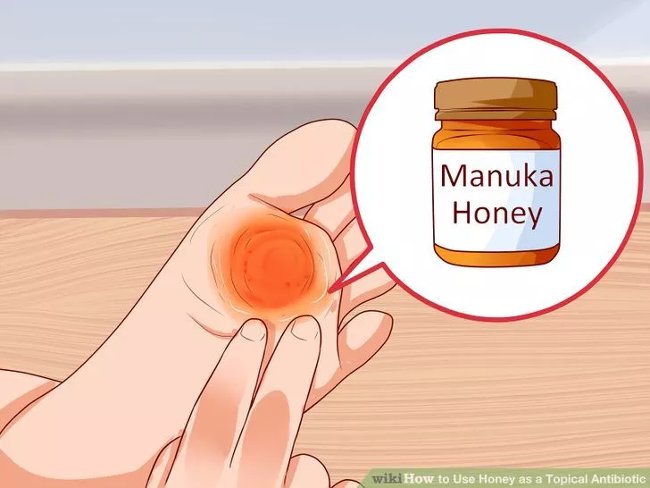
In addition, honey can also treat fungal skin infections effectively. You can apply honey directly or use honey bandages to apply to the affected skin. Moreover, honey can treat the following cases of fungal infections:
- Ringworm, also called tinea, causes itching all day, very annoying and unpleasant.
- Foot fungus is a fungal infection in the feet and toes.
- Seborrheic dermatitis is a common skin disorder that primarily affects the scalp, causing scales, itching, red skin and dandruff.
5. Treat dandruff

Besides, there is also evidence that honey can reduce dandruff and seborrheic dermatitis - chronic problems related to dandruff. Moreover, you may consider regularly putting honey on dandruff patches to treat dandruff and prevent dandruff from returning.
- Mix the solution with 90% honey and 10% water.Use that solution to rub the area of the dandruff within 2-3 minutes.Leave on for 3 hours, then wash your head with warm water.Repeat this treatment every day and continuously for two weeks or until dandruff is cleared.
- Continue to apply the method once a week to prevent dandruff from returning.
6. Treatment of itching
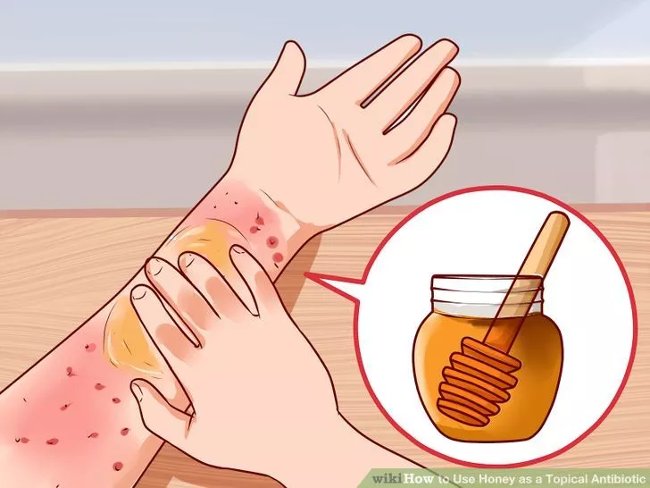
Allergic rashes, psoriasis and atopic dermatitis can cause skin itching or itching. This condition can cause pain, irritation and often become worse at night. Applying honey to the affected area reduces itching and prevents infection.
- Apply a thin layer of honey to the itchy skin, cover the area where the honey is applied or stay the same.However, you should cover it if you are wearing clothes or sleeping in a bed so that honey will not stick to the fabric.
Refer to some more articles:
- What happens if you mix honey with cinnamon powder every day?
- The first aid steps in time when the hand jammed into the door gap
- Measures to treat and treat food poisoning at home
Having fun!
You should read it
- How to drink the best honey of the day you need to know
- Honey is very good, but never combine them with these foods
- What happens if you mix honey with cinnamon powder every day?
- What is the effect of honey pickled garlic? How to soak garlic with honey
- Beat the hateful colds with honey
- The mystery of how people and birds communicate
- How to soak and preserve ginseng with standard honey at home
- The number of honey bees in the world decreased by nearly 12%
- Why is December called honey month?
- The effects of cordyceps honey soaked? How to soak?
- Insecticides harm the honey bee life
- 11 treatments for children to stop using antibiotics
May be interested

Why are wounds always worse than normal in the cold season?

6 health questions related to the screen

3 natural ways to enhance your vision effectively

11 simple solutions to eliminate bloating bloating

5 simple ways to minimize the impact of alcohol

These are the reasons you should cut down on salt in your diet






 How to drink the best honey of the day you need to know
How to drink the best honey of the day you need to know How to soak and preserve ginseng with standard honey at home
How to soak and preserve ginseng with standard honey at home Army Ants: The Most Dangerous Ants on the Planet, With Teeth That Can Heal Human Wounds
Army Ants: The Most Dangerous Ants on the Planet, With Teeth That Can Heal Human Wounds Honey is very good, but never combine them with these foods
Honey is very good, but never combine them with these foods What happens if you mix honey with cinnamon powder every day?
What happens if you mix honey with cinnamon powder every day? Breakthrough: Scientists invented a gel that can heal all wounds on the body and in the internal organs
Breakthrough: Scientists invented a gel that can heal all wounds on the body and in the internal organs